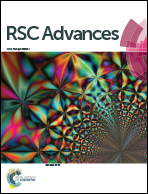The formation mechanism of fibrous metal oxalate prepared by ammonia coordination method†
Abstract
Anisotropic microstructures normally lead to different or better optical, electrical and magnetic properties for functional materials. We recently found some metal oxalates (nickel, cobalt, iron, silver, etc.) prepared in aqueous solutions will form fibrous morphology in the presence of ammonia (ammonia coordination method). Metals or metal oxides obtained by heating the fibrous metal oxalates in inert or oxidizing atmospheres can also inherit the high-aspect-ratio morphology. Ammonia coordination method is a simple and economical way to synthesize fibrous metal oxalates, metals, and metal oxides. In this work, fibrous nickel oxalate with a formula of Ni(NH3)1.7C2O4·2.2H2O and its corresponding single crystal were synthesized to investigate the morphology transitions, structure transitions, and formation mechanism of fibrous particles. Ammonia molecules gradually coordinating with nickel atoms, which caused the increase of surface energy and atomic stacking rate of (020) crystal plane, was the fundamental reason for the oriented growth of nickel oxalate. Our results demonstrate a feasible method to synthesize high-aspect-ratio metallic materials and show the important influences of coordination ligand ammonia on the crystal growth stage of metallic materials which may provide references for synthesizing metallic materials with extraordinary microstructures and better properties by simple ammonia coordination method.



 Please wait while we load your content...
Please wait while we load your content...